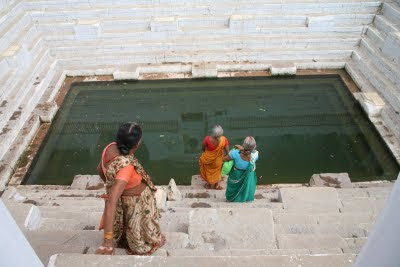The Indian Himalaya. Treasured by Indians and foreigners as a refuge from the rest of the country's brutal heat. Himachal Pradesh (H.P.) is home to many Tibetan refugees as well as many distinct mountain ethnic groups. Many Indian honeymooners come to these "hill stations" to see their first snow; during the colonial period, the British ran to them to remember what its like to be cold again and we did too. Max left Chandigarh and stopped in a couple of towns in Himachal outside of Shimla, the former summer capital for the British empire in India. The highlight of his journey was the hot springs at Tatopani where he could walk from his small guesthouse to the bathing pools without even having to put shoes on. Knowing that Kara would want a few days to recooperate from her trip back from Europe, he chose a small town called Naggar for their meeting place. After a 8 hour plane journey, a 10 hour wait in the airport in Delhi, and an 18-hour bus ride, they were reunited. Seen above is a view of the Kullu Valley.
Naggar. Fresh air, beautiful mountain views, and hundreds of apple groves. All there is to do is walk around and take in the scenery--and that is enough. Here Max walks through a field of naturally growing cannabis. They grow rampantly throughout this section of the Himalaya.
This is the view from our homestay in Naggar. Max met up with a family who rents the bottom two rooms of their house to local and foreign tourists. It was nice to spend time with a local family. They cooked excellent food and the rates were very reasonable. Like many of the families in this area, the father owned an apple grove. The majority of apples sold in India come from this state.
Gauri Shankar Shiva Temple, Naggar. This small temple is a miniature masterpiece built between the 11th and 12th centuries! Two of the daughters dressed Kara in their clothing and makeup and brought her and Max to the evening puja.
The eldest daughter was really into treating Kara like her own personal Barbie doll. It was fun. Every night we would sit in their living room and talk or watch Hindi soap operas before going to bed. Before we left, the eldest daughter gave Kara one of her scarfs and kohl as a parting gift. The father encouraged Max to come back to work on his apple farm. They were a kind family and we enjoyed staying with them.
Hiking around Naggar. We met a group of giggling teenagers along the way and had a rather long photo shoot with them.
After 5 days in Naggar, we made our way up the valley to Vashisht, a town just 5 kilometers from the tourist hub of Manali. Manali was a popular stop on the "hippie trail" for years and still remains a place for long term travelers to relax and recharge. It is also the last major town on the route to Leh and Ladakh. Max is decked out in his most colorful outfit in front of a map of the region. He is sporting a traditional H.P. topi.
Mild traffic jam.
As it is the last major stop before the treacherous 473 kilometer journey to Leh, northbound goods trucks and adventure-seeking motorcyclists take the opportunity to refuel and retool at the town's many mechanic shops.
Walking over the Kullu River to Vashisht.
Kara loves hill stations.
Hot springs! Vashisht is blessed with an unlimited supply of scalding hot water, and the townsfolk are appropriately grateful. The source of the springs has a temple built around it where locals come daily to wash and pray. Foreigners are also welcomed into the temple's relaxing sulfuric pools. Inside the temple there are two pools for men and women separated by an ancient stone wall. Kara was pleasantly surprised to see that the strict taboo against nudity dissolved into the steam of the women's bathing area. It was the first time Kara ever saw an Indian woman showing her full skin in the 11 months she has spent in India. Go women of Vashisht! she says. Max was disappointed that the men's pool was in full view of the street above, and so he could not enjoy full relaxation in his birthday suit. Both pools are piping hot and it is a test of endurance to submerge one's full body in the holy water. We always left the hot springs completely rejuvenated and calm. Unfortunately photos are prohibited in the temple, so we can only show you what the public pool outside of the temple looks like--seen above.

Giant bunny. Several Manali locals earn their livelihood by holding giant angora rabbits for tourists to oggle and take pictures of. We really wanted to touch this rabbit so we paid 5 rupees for the privilege.

We went to the hot springs every day, sometimes 3 times a day. Seen here is another public hot spring station where many people come to wash their dishes and do their laundry. Behind the washing station you can see the stone-slated roofs of the temple.

Sleepless at dawn, we woke up early on the last day of our time here to enjoy the sunrise over the valley. A week in the Kullu Valley was enough time to restore us to full health before planning on trekking in the neighboring Spiti Valley. We would need every ounce of strength for the next section of our trip....
Kara and Max































































